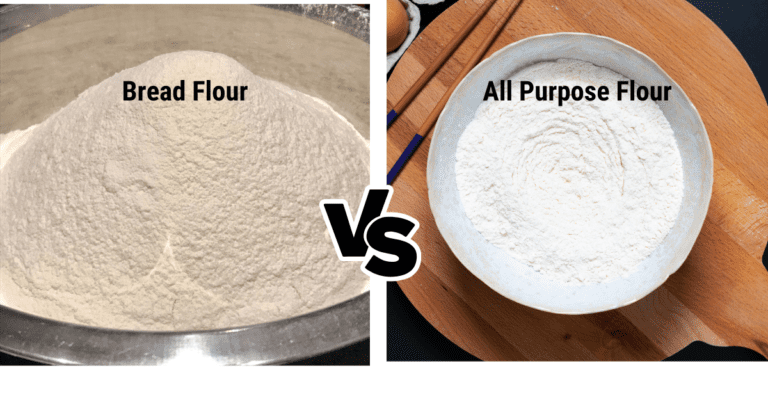In the world of baking, the choice of flour can make a huge difference in the outcome. Understanding the difference between bread flour and all-purpose flour is critical to achieving the desired texture and structure in baked goods. Let’s take a look at the characteristics of these two commonly used flours.
Basic types of flour in baking
The basic types of flour commonly used for baking are:
All-purpose flour: An all-purpose flour suitable for a wide range of baked goods.
Whole Wheat Flour: Made from whole wheat grains and has a high fiber content.
Bread Flour: A high-protein flour perfect for yeast-based breads and pizza dough.
Cake Flour: A fine-grained flour with a low protein content, ideal for soft cakes.
Pastry Flour: A finely ground flour that has slightly more protein than cake flour and is used for pastries and pie crusts.
Self-rising flour: For convenience, it is pre-mixed with leavening agents such as baking powder and salt.
Gluten-Free Flour: For those with gluten sensitivities, we have blended a variety of gluten-free grains.
Almond Flour: Almond flour is used in gluten-free and grain-free baking.
Coconut flour: Made from desiccated coconut meat, it is rich in fiber and low in carbohydrates.
Rye flour: Produces rich, flavorful bread and adds a unique flavor to baked goods.
These are just a few examples; there are many other specialty flours that can be used for a variety of baking purposes.
Using the right type of flour for bread making is essential. Different flours have different protein contents, which affect texture and structure. All-purpose flour is suitable for a wide range of recipes, while bread flour creates a chewier texture suitable for breads and pizzas. Cake flour gives cakes and pastries a soft, delicate texture.
This sourdough bread kit includes everything you need to start making beautiful and delicious artisan-style sourdough bread at home. Sourdough bread starter kit equipment may differ from the photo. What’s in the Kit? Each kit includes one San Francisco-style sourdough starter culture. 1 x Bread glitter…
Proper selection of flour will give you the desired result. The gluten in flour provides structure and allows the dough to rise. Flour also imparts a unique flavor and enhances the flavor profile. Absorption rates vary and affect water balance.
Success is guaranteed if you follow the flour type specified in the recipe, as bakers develop and test their flours with great care. Ultimately, using the right flour type will ensure optimal texture, structure, flavor, and overall superior baked goods.
Understanding bread flour and all-purpose flour

Bread flour and all-purpose flour differ in protein content, texture, and recommended baking uses.
Protein content and its role in gluten production
Bread flour typically has a higher protein content than all-purpose flour. Bread flour usually contains about 12-14% protein, while all-purpose flour usually contains about 9-12% protein. The high protein content in bread flour contributes to the formation of gluten, resulting in a firmer and more elastic dough.
Differences in texture and rise: All-purpose flour and strong flour
Bread flour has a high protein content, which gives baked goods more chewiness and density. Gluten, which forms during mixing and kneading, gives bread made with bread flour its unique structure and texture. All-purpose flour, on the other hand, has a slightly lower protein content and less gluten formation, creating a lighter, softer texture in baked goods.
When to use bread flour and all-purpose flour
Bread flour is specially formulated for baking bread, pizza dough, bagels, and other yeast-based recipes. The higher protein content supports the fermentation process and provides the structure and strength needed to ferment well and create a chewy and elastic end product. All-purpose flour, as its name suggests, is more versatile and can be used in a wide range of baking recipes. Suitable for making cakes, cookies, muffins, quick breads and many other baked goods.
It’s important to note that bread flour and all-purpose flour have specific uses, but may be substituted depending on the desired result. However, substitutions can affect the texture and structure of the final baked goods. If a recipe calls for particularly strong flour, using all-purpose flour instead may give you a slightly lighter texture, but substituting strong flour for all-purpose flour may give you a richer texture. There is. For the most reliable and consistent results, it’s best to follow the type of flour recommended in the recipe.
Make sourdough bread with strong and all-purpose flour

When making sourdough bread, using strong or all-purpose flour will give you different results and different benefits. Keep reading to learn about the benefits of using bread flour, the consequences of using bread flour vs. all-purpose flour, and tips for handling bread flour to prevent hardness.
See also: Sourdough flatbread
Advantages of using bread flour for sourdough bread
Bread flour typically has a higher protein content compared to all-purpose flour. The higher protein content (approximately 12-14%) contributes to the formation of gluten, which improves the structure of sourdough bread and gives it a chewy texture.
See also: Sourdough Starter Recipe
Try both flours in your sourdough boule recipe
Both bread flour and all-purpose flour can be used successfully in sourdough boule recipes, each yielding slightly different textures and flavors. I tried it and here are the results:
bread crumbs
Texture: Bread made with bread flour had a chewier texture and denser crumb.
Rising: The bread rose well, with a slightly noticeable oven spring.
Overall quality: The bread had a strong flavor and firm structure, making it perfect for sandwiches and toast.
all-purpose flour
Texture: Bread made with all-purpose flour had a softer, softer texture and the crumb was slightly more open.
Rise: The bread had a good rise, but the oven spring was slightly less pronounced compared to the bread flour version.
Overall quality: The bread has a mild flavor and light structure, making it suitable for a variety of uses, including as a base for toppings and as a breakfast bread.
See related article: Is sourdough bread good for your health?
Tips for handling breadcrumbs and preventing hardness in sourdough bread

Proper hydration: Due to its high protein content, bread flour absorbs more water than all-purpose flour. Adjust hydration level accordingly to achieve proper dough consistency. Adding too little water will make the dough dry and stiff, while adding too much will make it too sticky and difficult to handle.
Gentle mixing and kneading: When using bread flour, avoid over-mixing or over-kneading the dough. Gluten development is important, but over-mixing can make the bread tough. Mix and knead until the dough is smooth and elastic, but not too much.
Automatic decomposition methods: Consider using automatic decomposition methods. This method requires mixing the flour and water and letting it rest before adding the sourdough starter and salt. This technique fully hydrates the flour, improving gluten development and improving dough handling.
See related topic: Wholemeal Sourdough Starter
The ultimate showdown: The difference between strong flour and all-purpose flour
In conclusion, the difference between strong and all-purpose flour is the protein content, which directly affects the texture and structure of baked goods. Bread flour, with its high protein content, is perfect for achieving a chewier, denser texture, making it ideal for hearty bread recipes.
All-purpose flour, on the other hand, has a moderate protein content, is more versatile, and has a softer crumb, making it suitable for a wide range of baked goods. Understanding these differences allows bakers to make informed choices and achieve desired results in their culinary creations. Whether you want to make firm breads or delicate pastries, choosing the right flour is the key to baking success.



